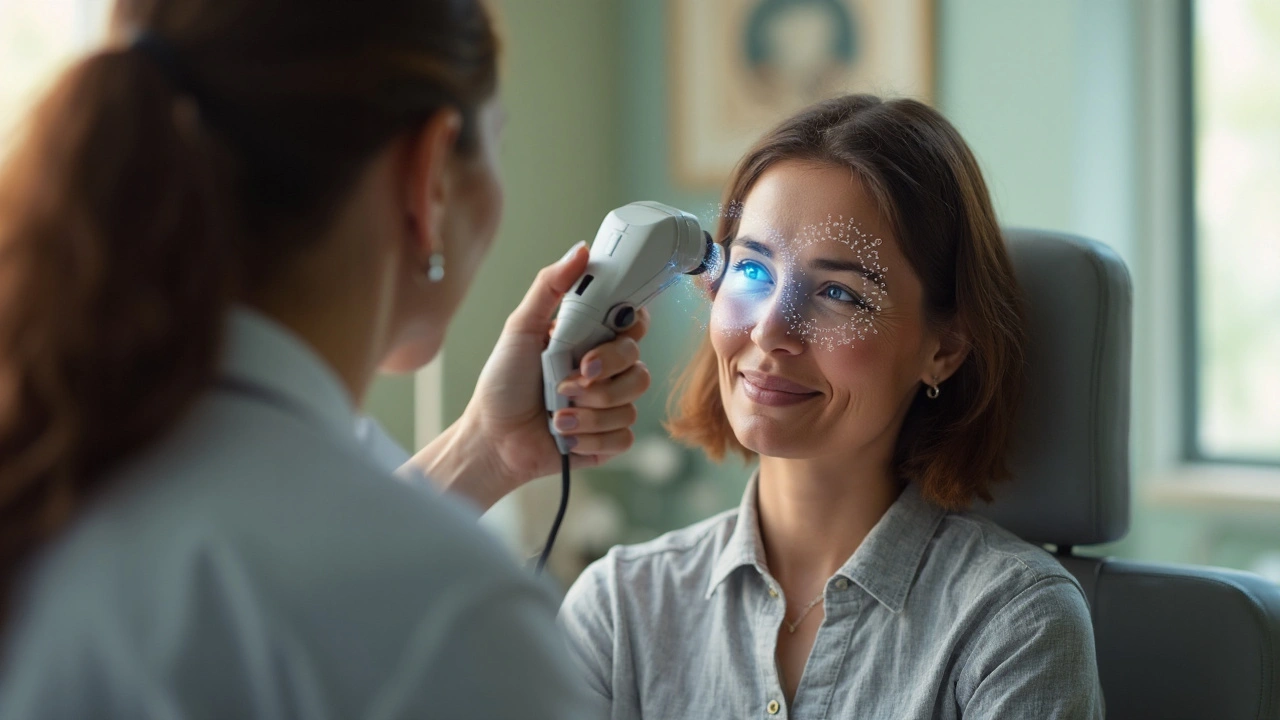24 Sep 2025
- 20 Comments
TL;DR
- Type2 diabetes raises risk of diabetic retinopathy, macular edema, cataract and glaucoma.
- Maintain HbA1c <7% and blood pressure <130/80mmHg to cut eye‑damage risk.
- Annual NHS eye screening and prompt treatment can preserve sight.
- Healthy diet, regular exercise and quitting smoking boost retinal health.
- Effective therapies include laser photocoagulation and anti‑VEGF injections.
Living with Type 2 Diabetes is a chronic metabolic condition that causes elevated blood glucose levels. Over time, that excess sugar harms tiny blood vessels throughout the body - the retina being especially vulnerable. If you’ve been diagnosed, protecting your eyesight becomes just as critical as managing your blood sugar. Below you’ll find a step‑by‑step guide to understand the risks, spot early signs, and take concrete actions that keep your vision clear.
How High Blood Sugar Threatens Your Eyes
When glucose builds up in the bloodstream, the body tries to filter it through the kidneys and blood vessels. In the retina, diabetic retinopathy a progressive eye disease caused by damaged retinal blood vessels emerges as the most common complication. The high‑sugar environment forces these vessels to leak fluid or grow fragile new ones, which can lead to swelling (macular edema) and, eventually, vision loss.
Two key biomarkers track this damage:
- HbA1c average blood glucose over the past 2‑3 months, expressed as a percentage. Keeping it below 7% dramatically lowers retinopathy risk.
- Blood Pressure the force of blood against arterial walls, measured in mmHg. Values under 130/80mmHg synergize with glucose control to protect retinal vessels.
Beyond retinopathy, uncontrolled diabetes increases the odds of cataract formation and glaucoma - both of which can further impair vision if left untreated.
Common Eye Complications Linked to Type 2 Diabetes
Understanding each condition helps you recognise symptoms early:
- Diabetic Retinopathy: Divided into non‑proliferative (early) and proliferative (advanced) stages. Early signs include micro‑aneurysms and occasional floaters.
- Diabetic Macular Edema (DME): Fluid buildup in the central retina (macula) leads to blurred or distorted central vision.
- Cataract: Clouding of the eye’s lens; diabetics tend to develop cataracts up to a decade earlier.
- Glaucoma: Increased intra‑ocular pressure that can damage the optic nerve, with diabetes amplifying the risk.
Each of these conditions shares a common root - compromised blood flow and inflammatory pathways triggered by chronic hyperglycaemia.
Screening and Early Detection in the UK
The NHS runs a dedicated Eye Screening Programme a free annual retinal photograph service for people with diabetes in England, Wales and Northern Ireland. The programme targets people aged 12 and over, aiming to catch retinopathy before symptoms appear.
Screening options include:
| Method | Depth of View | Typical NHS Cost | Recommended Frequency |
|---|---|---|---|
| Dilated Fundus Photography | 2‑D retinal image, covers >80% of retina | Free via NHS screening | Yearly |
| Optical Coherence Tomography (OCT) | Cross‑sectional 3‑D view, detects fluid layers | £150‑£200 (often covered after referral) | Every 6‑12months if DME risk |
| Fluorescein Angiography | Highlights leaking vessels with dye | £250‑£350 (specialist‑only) | When laser/anti‑VEGF planned |
If your retinal photos show any abnormalities, your ophthalmologist a medical doctor specializing in eye diseases and surgery may order an OCT or fluorescein angiography for a deeper look.

Treatment Options to Preserve Vision
When eye damage is caught early, several interventions can halt or even reverse vision loss:
- Laser Photocoagulation: Burns small spots on the retina to seal leaking vessels; effective for proliferative retinopathy.
- Anti‑VEGF Therapy, such as ranibizumab a medication that blocks vascular endothelial growth factor to reduce retinal swelling. Injections are usually given monthly for the first three months, then as needed.
- Intravitreal Steroids: Corticosteroid implants can reduce macular edema when anti‑VEGF isn’t sufficient.
- Surgical Options: Vitrectomy removes scar tissue and blood from the eye in advanced cases.
Success rates are high - studies from the UK National Diabetic Eye Screening Programme report a 90% preservation of 6/12 vision (roughly 20/40 Snellen) when treatment starts within three months of diagnosis.
Lifestyle Strategies That Keep Your Vision Sharp
Beyond medical care, everyday habits have a measurable impact on retinal health:
- Balanced Diet: Emphasise low‑glycemic index foods (whole grains, legumes, berries). A 2023 UK cohort study linked a Mediterranean‑style diet to a 30% reduction in retinopathy progression.
- Regular Exercise: Aim for at least 150minutes of moderate activity weekly. Physical activity improves insulin sensitivity, lowering HbA1c.
- Weight Management: Maintaining a BMI under 25kg/m² reduces both glucose spikes and blood pressure.
- Quit Smoking: Smoking doubles the odds of macular edema; cessation programs are offered through many NHS trusts.
- Blood Sugar Monitoring: Use a CGM or regular finger‑stick checks to keep daily glucose within target ranges (4‑10mmol/L fasting).
Combine these steps with strict medication adherence, and you’ll give your retina the best chance to stay healthy for decades.
Related Topics to Explore Next
Now that you understand the link between type 2 diabetes and eye health, you might want to dig deeper into:
- Understanding insulin resistance and its role in glucose control.
- How continuous glucose monitors (CGMs) improve real‑time management.
- Nutrition guides focused on low‑glycaemic index meals for diabetics.
- Detailed walkthrough of anti‑VEGF injection procedures and patient experiences.
- Impact of stress management on blood pressure and retinal health.
Each of these areas builds on the foundation laid here, giving you a roadmap to holistic diabetes care.

Frequently Asked Questions
How often should I have an eye exam if I have type 2 diabetes?
The NHS recommends a yearly retinal photograph through the Eye Screening Programme. If you have any retinopathy, your ophthalmologist may advise 3‑monthly OCT scans or visits.
Can good blood sugar control really prevent eye problems?
Yes. Maintaining HbA1c below 7% cuts the risk of developing diabetic retinopathy by about 50% and slows progression of existing disease.
What are the early signs of diabetic eye disease?
Often there are none at first. Some people notice occasional floaters, blurred spots, or difficulty reading fine print. Any sudden change warrants an urgent eye check.
Are anti‑VEGF injections safe?
Clinical trials and NHS data show a safety profile comparable to routine vaccinations. Risks include mild eye irritation and very rare infections, but benefits usually outweigh them.
Does cataract surgery affect diabetic retinopathy?
Cataract removal itself does not worsen retinopathy, but a thorough retinal exam is needed before surgery. In some cases, a combined procedure with laser treatment is planned.


Jennifer Harris
September 24, 2025I've been reading up on how fluctuating blood sugar can damage the tiny blood vessels in the retina, and it really underscores the importance of regular eye exams. Even mild hyperglycemia can start the cascade that leads to microaneurysms. Keeping HbA1c in check and staying on top of blood pressure seems like the best preventive combo. It’s amazing how a few lifestyle tweaks can spare you future vision loss.
Northern Lass
September 29, 2025Whilst the prevailing consensus extols the virtues of glycemic control, one must not overlook the insidious role of systemic inflammation, a factor seldom accorded due prominence. It is, perchance, the very underbelly of diabetic retinopathy that eludes superficial scrutiny. One should therefore interrogate the cytokine milieu as rigorously as one does glucose metrics.
Johanna Sinisalo
October 3, 2025Let’s remember that managing diabetes isn’t just about numbers; it’s about building sustainable habits. Scheduling a quarterly ophthalmology appointment and pairing it with a balanced diet can forge a resilient defense against macular edema. I’ve seen patients thrive when they track their vision changes alongside their glucose logs.
surender kumar
October 7, 2025Oh, brilliant, another reminder that our eyes are apparently the most fragile organ you can mess up with a donut. Sure, let’s all panic and buy sunglasses for our retinas while ignoring the fact that consistent medication adherence is the real hero here.
Shelby Rock
October 11, 2025life's weird, y'know? you think you got control till your blood sugar screams and your eyes start whispering. maybe it's a sign that the body talks in riddles, yo.
Dhananjay Sampath
October 15, 2025Indeed, establishing a routine-, especially one that intertwines ophthalmic check‑ups with nutritional planning-, creates a synergistic effect that can markedly diminish the progression of diabetic ocular complications., Moreover, involving family members in these appointments can reinforce adherence to treatment regimens.,
kunal ember
October 19, 2025Diabetic retinopathy, a microvascular disorder precipitated by chronic hyperglycemia, constitutes the principal cause of preventable blindness among working‑age adults worldwide. The pathophysiology commences with pericyte loss, leading to capillary basement membrane thickening and subsequent retinal ischemia. In response, the retina secretes vascular endothelial growth factor (VEGF), which, while initially compensatory, ultimately drives neovascular proliferation and increased vascular permeability. This cascade culminates in the formation of microaneurysms, intraretinal hemorrhages, and, in advanced stages, fibro‑vascular membranes that may contract and precipitate tractional retinal detachment. Concurrently, macular edema-the accumulation of extracellular fluid within the macular layers-can arise from the breakdown of the blood‑retinal barrier, further compromising central visual acuity. Epidemiological data reveal that the prevalence of any retinopathy escalates proportionally with disease duration, with roughly one‑third of individuals manifesting clinically significant lesions after a decade of type‑2 diabetes. Glycemic control, quantified by HbA1c, remains the cornerstone of risk mitigation; nevertheless, tight control must be balanced against hypoglycemic episodes, particularly in elderly populations. Systemic hypertension synergistically amplifies retinal vessel stress, underscoring the necessity of antihypertensive therapy tailored to each patient’s profile. Dyslipidemia, especially elevated LDL and triglycerides, contributes to endothelial dysfunction and is thus implicated in disease progression. Lifestyle interventions-dietary modification, regular aerobic exercise, and smoking cessation-exert ancillary benefits by improving insulin sensitivity and reducing oxidative stress. Pharmacologic advances, such as intravitreal anti‑VEGF agents, have revolutionized the management of proliferative disease and macular edema, offering visual preservation where laser photocoagulation once reigned supreme. Yet, these treatments are not curative; they demand lifelong monitoring and repeat injections, imposing a substantial burden on healthcare resources. Preventive ophthalmic screening, ideally commencing five years after diagnosis and conducted annually thereafter, facilitates early detection when interventions are most effective. Patient education remains pivotal; individuals must comprehend that asymptomatic phases do not preclude irreversible retinal damage. In sum, a multidisciplinary approach-integrating endocrinology, ophthalmology, nutrition, and primary care-optimizes outcomes and sustains visual function for those navigating the complexities of type‑2 diabetes.
Kelly Aparecida Bhering da Silva
October 23, 2025Well said, but let's not forget the power of community health drives to reach underserved patients.
Michelle Dela Merced
October 27, 2025Eye exams saved my vision 🙌👀
Alex Iosa
October 31, 2025Indeed, the empirical evidence substantiates routine ophthalmoscopic evaluation as a non‑negotiable component of comprehensive diabetes management.
melissa hird
November 4, 2025Ah, the age‑old tale: sugar spikes, retina trips-nothing new, yet somehow the internet treats it like a revelation worthy of viral memes.
Mark Conner
November 8, 2025Stop acting like we didn't know that. Just get your eyes checked before you blame the donuts.
Charu Gupta
November 12, 2025It is incumbent upon each practitioner to disseminate the prophylactic protocols with diligence, thereby averting the insidious encroachment of retinal pathology. 📚
Abraham Gayah
November 17, 2025Sure, like reading a textbook will stop your eye from leaking fluid. Real life needs real action, not just words.
rajendra kanoujiya
November 21, 2025Honestly, the whole hype around diabetic eye disease feels like a scare tactic to sell more eye drops.
Caley Ross
November 25, 2025While the market does profit, ignoring the medical data could cost more than any supplement.
Bobby Hartono
November 29, 2025i totally get that the news can sound overblown, but when i look back at the time my aunt's vision blurred overnight, it wasnt some random glitch-it was her uncontrolled diabetes finally showing up in her retina. the eye docs told us early detection could have saved a lot of hassle. so yeah, keep those doctor appointments on your calendar like you would a birthday. also, cutting down on sugary drinks actually makes the eyes feel less tired. just saying, ain't no harm in being a bit proactive.
George Frengos
December 3, 2025Your anecdote powerfully illustrates the tangible benefits of vigilance; therefore, I encourage all readers to integrate regular ophthalmic evaluations into their diabetes care regimen with unwavering commitment.
Jonathan S
December 7, 2025It's absurd how many people neglect eye health while obsessing over carbs; wake up already! 👀
Charles Markley
December 11, 2025Such hyperbolic rhetoric neglects the nuanced interplay of glycemic indices, vascular autoregulation, and retinal neurodegeneration, thereby reducing a complex pathophysiological spectrum to a simplistic admonition.